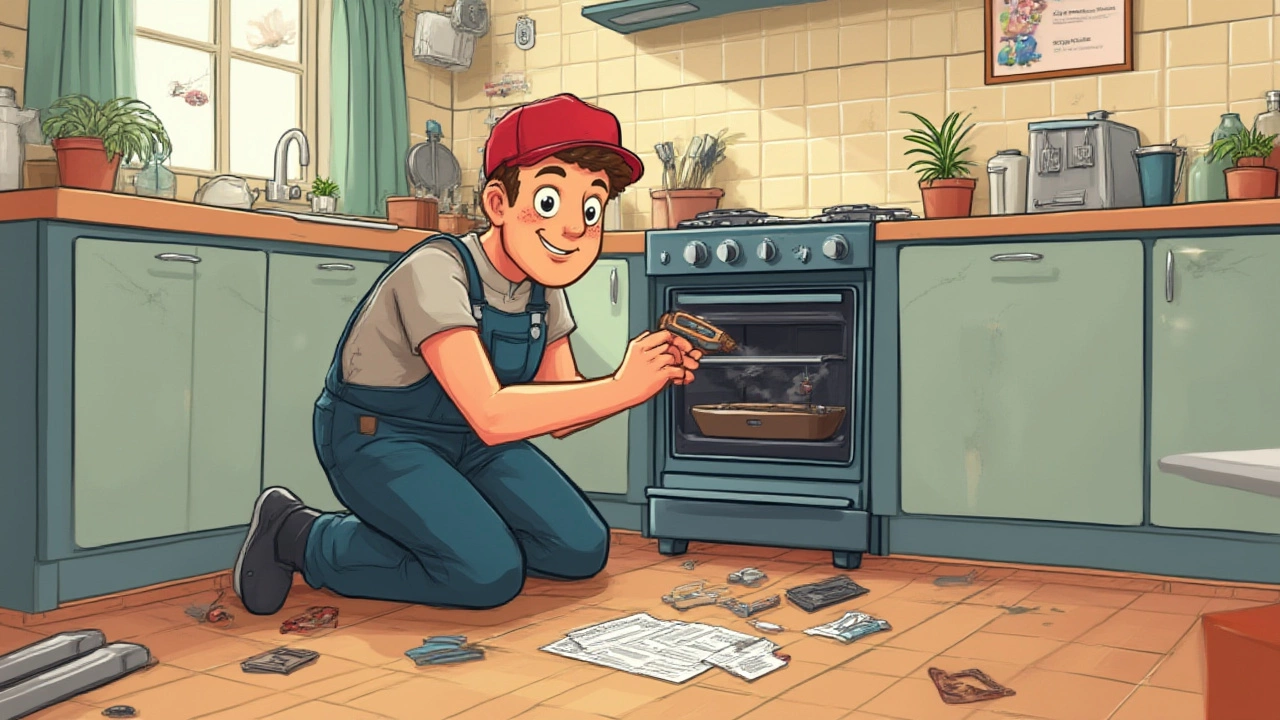Can you imagine prepping for pizza night, pizza stone dusted with flour, friends hungry, and then—your trusty oven won’t fire up? No lights, no heat, just tumbleweeds where your homemade pie should be. Now you’re faced with a head-scratcher: is it even worth fixing a 10-year-old oven?
The Life Expectancy of Your Oven: More Than Just Numbers
Ovens are a lot like old sneakers; they seem fine until one day, something gives. But here’s the thing: most ovens, whether gas or electric, are built to last somewhere between 10 and 15 years. According to recent service reports and manufacturer data in 2024, the sweet spot for major appliance life expectancy puts ovens a tad over 13 years on average. So at 10 years, yours isn’t youthfully springy, but it’s definitely not ancient. Here’s a little known fact—many ovens start showing quirks by the 8-year mark, but major breakdowns usually arrive after the decade mark. Some brands like Bosch or Miele push well past 15 years if they’re well looked after. Whirlpool and GE tend to be on the middle to high end for repair-friendliness and spare part availability, while budget models can throw in the towel closer to year 9 or 10. What’s behind these stats? It’s not just brand but how much you ask from your oven. Baking every week versus the occasional Sunday roast can mean a world of difference. Excessive self-cleaning cycles can wear out parts early—be honest, how many times have you hit self-clean?
Keep in mind oven technology hit a big leap around 2017. Touchscreens, smart sensors, and even oven WiFi arrived. If your appliance predates these updates, repairs might be as much about patching up old tech as fixing parts. That’s not a deal breaker for everyone—some home cooks prefer dials over finicky apps. But you’ll want to weigh this if you’re eyeing more modern features. Disposable culture has us thinking any appliance hitting double digits belongs in a museum. But data shows a full third of 10-year-old ovens just need a small fix: new bake elements, igniters, or temperature sensors. So if yours is the family workhorse, that decade mark isn’t a death sentence. With the right TLC, the thing might chug along for years.
Here’s one tip the big box stores won’t tell you: factory original parts for major brands made before 2019 are usually higher in quality than many generic replacements. Even used ovens stripped for parts on eBay or local repair shops can be a goldmine for giving your appliance a second act. But double check compatibility before buying—serial number mismatches can waste both time and cash. If you want your oven to outlast your kitchen paint color, stick to basic cleaning, watch those door gaskets (which can kill efficiency), and stay alert for subtle issues like hot spots or slow preheats. Problems detected early are usually way cheaper to fix.

Cost of Repairs Versus Replacement: The Real Math in 2025
Here’s where most people freeze. One minute you’re pricing heating elements, the next you’re scrolling through a homeware site gawking at the price of new ovens. The real cost of fixing a 10-year-old oven, though, is usually about balancing a repair that extends life versus paying for brand-new reliability. Let’s talk honest numbers: in mid-2025, the average professional oven repair in the UK hovers around £100-250 for common issues—think igniter, thermostat, or control panel. Heating element swaps are often well under £150. If you’re a bit handy, a new bake element from a supplier could run you as little as £30-£50. The labor is usually what hurts if you call the pros—a fair call if you don’t feel like wrestling with wires under your counter.
Now, put that next to the cost of a new oven. Even for a basic, no-frills built-in model, expect upwards of £350-£700. Want convection, smart features, or a designer finish? Some of those touch £1,200—and premium brands can go much higher. You’ll also need to budget for safe installation (gas or electric), which can add another £80-£200. Plus, there’s the hassle: measuring, waiting for delivery, possibly even cutting cabinets. For renters or those in older homes, this disruption can be a major factor in the cost-benefit analysis.
Something else to consider—warranty. Sure, new ovens come with a glossy sheet promising two years of peace of mind. But after that? Many mid-market brands aren’t built for repairs past year five. Ironically, sometimes it’s easier to find parts for your old oven than for a flashy new one five years down the line. If you’re paying over half the price of a replacement to repair, you really want to be sure there are no other problems lurking. Unusually high repair bills—like a failed circuit board or a cracked ceramic top—are rarely worth it. Watch out for cascading failures too; an old oven that’s gone through two or more major repairs in the last 18 months is probably headed for more headaches soon.
Energy efficiency does matter for people watching their bills. Ovens use a lot of power, but the difference in running costs between a 2015 model and a 2025 one isn’t wild— maybe a few pounds a year, unless your oven is broken and never quite reaches temperature. Don’t get scammed by claims of £100+/year savings on energy unless you’re baking daily and your old oven has totally failed insulation. The real juice is in using your oven right: not opening the door a dozen times mid-bake, fitting trays snugly, and making sure those door gaskets form a proper seal. That’ll save you more than jumping model years.
For most repairs under £200, especially on brands with strong reputations, fixing your oven can be a smart bet. If the problem is a cracked glass, fried computer board, or multiple failed components, it’s probably time to let go. But don’t decide in a panic—a quick professional diagnostic can save a lot of money and regret.

Fix, Replace, or Upgrade: How to Decide What Makes Sense
Sometimes the answer is crystal clear. If the oven’s leaking gas, you get weird electrical smells, or the case feels hot enough to fry bacon on top—stop, unplug, and call in a pro. Those are flat-out safety issues, and no repair is worth risking your home or health. But if it’s small stuff like an oven light, a door that sticks, or uneven heating? That’s home-repair territory all day. Let’s break down a simple approach to choosing your next move:
- Cost of Repair vs. Replacement: Grab your total repair quote and check it against the price for a comparable new model. If repair is less than half the cost of buying new—and the oven’s given you few headaches—repair looks good.
- Age and Brand: At 10 years, a mid- or high-end oven from a respected maker still has life left, especially if parts are available. Barebones discount models don’t always make sense to fix past year 8 unless it’s a super easy part swap.
- Repair History: Has this oven been trouble-free until now? Great. But if it’s already had three service visits in two years, get ready for repeat incidents—time to consider a replacement.
- Your Cooking Needs: Big on baking or love precise temperatures? Modern ovens can have game-changing features—air fry, precision roasting, rapid preheat, integrated meat probes. Your older oven won’t magically download these, so upgrading could add real value to your kitchen habits.
- Environmental Impact: It can feel wasteful to dump an oven just because a single part failed. Repairing keeps appliances out of landfill. Only swap if you absolutely need to, and recycle your old unit responsibly.
Do you know more than half of oven malfunctions stem from user mishaps? Accidentally hitting the child lock, setting the clock wrong, or pressing obscure modes can all look like breakdowns. Always check the basics—circuit breakers, plug sockets, oven settings—before calling for help. You’d be shocked how many service calls are resolved by a simple reset.
For DIYers, YouTube and manufacturer support sites are your friend. Common fixes like changing a bake element, replacing a door seal, or swapping a thermostat are often doable without special tools. Watch a repair video for your oven’s exact model and see if you’re comfortable—just always kill the power first! But never mess with gas lines or main wiring if you’re even slightly unsure. Safety trumps saving a few quid.
If you go the repair route, ask your service tech about parts warranties. Some quality repair shops offer guarantees on labour and parts, especially for common fixes. This can stretch your oven’s viable life by a couple more years. And hey, there’s a weird satisfaction in keeping a trusted appliance running longer than your neighbour’s latest model.
Final tip? Don’t ignore the oven just because it works ‘most’ of the time. Odd noises, flickering displays, or doors that won’t seal can signal bigger issues brewing. Deal with them early to dodge pricier fixes later. But if you crave that shiny, app-connected oven and have the funds—sometimes, all the logic in the world can’t beat the thrill of an upgrade. For the rest of us, a smart repair gives you the best bang for your buck and keeps your kitchen humming without a hiccup.
